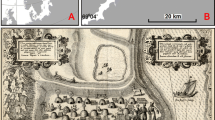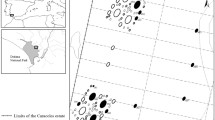Abstract
The Allee effect can result in a negative population growth rate at low population density. Consequently, populations below a minimum (critical) density are unlikely to persist. A lower limit on population size should constrain the loss of genetic variability due to genetic drift during population bottlenecks or founder events. We explored this phenomenon by modeling changes in genetic variability and differentiation during simulated bottlenecks of the alpine copepod, Hesperodiaptomus shoshone. Lake surveys, whole-lake re-introduction experiments and model calculations all indicate that H. shoshone should be unlikely to establish or persist at densities less than 0.5–5 individuals m−3. We estimated the corresponding range in minimum effective population size using the distribution of habitat (lake) sizes in nature and used these values to model the expected heterozygosity, allelic richness and genetic differentiation resulting from population bottlenecks. We found that during realistic bottlenecks or founder events, >90% of H. shoshone populations in the Sierra Nevada may be resistant to significant changes in heterozygosity or genetic distance, and 70–75% of populations may lose <10% of allelic richness. We suggest that ecological constraints on minimum population size be considered when using genetic markers to estimate historical population dynamics.





Similar content being viewed by others
References
Allee WC, Emerson A et al (1949) Principles of animal ecology. Saunders, Philadelphia
Allan JD (1976) Life history pattern in zooplankton. Am Nat 110:165–180
Berggren A (2001) Colonization success in Roesel’s bush-cricket Metrioptera roeseli: the effects of propagule size. Ecology 82:274–280
Boileau MG, Hebert PDN (1988) Genetic differentiation of fresh-water pond copepods at Arctic sites. Hydrobiologia 167:393–400
Boileau MG, Hebert PDN (1991) Genetic consequences of passive dispersal in pond-dwelling copepods. Evolution 45:721–733
Boileau MG, Hebert PDN, Schwartz SS (1992) Non-equilibrium gene frequency divergence: persistent founder effects in natural populations. J Evol Biol 5:25–39
Bucklin A, Wiebe P (1998) Low mitochondrial diversity and small effective population sizes of the copepods Calanus finmarchicus and Nannocalanus minor: possible impact of climatic variation during recent glaciation. J Hered 89:383-392
Buskey EJ, Peterson JO, Ambler JW (1996) The swarming behavior of the copepod Dioithona oculata: in situ and laboratory studies. Limnol Oceanogr 41:513–521
Chakraborty R, Nei M (1977) Bottleneck effects on average heterozygosity and genetic distance with stepwise mutation model. Evolution 31:347–356
Courchamp F, Clutton-Brock T, Grenfell B (1999) Inverse density dependence and the Allee effect. Trends Ecol Evol 14:405–410
Doall MH, Colin SP, Strickler JR, Yen J (1998) Locating a mate in 3D: the case of Temora longicornis. Philos Trans R Soc Lond B Biol Sci 353:681–689
Forsyth SA (2003) Density-dependent seed set in the Haleakala silversword: evidence for an Allee effect. Oecologia 136:551–557
Gascoigne JA, Lipcius RN (2004) Allee effects in marine systems. Mar Ecol Prog Ser 269:49–59
Gerritsen J (1980) Sex and parthenogenesis in sparse populations. Am Nat 115:718–742
Glenn TC, Stephan W, Braun MJ (1999) Effects of a population bottleneck on Whooping Crane mitochondrial DNA variation. Conserv Biol 13:1097–1107
Hairston NG, Brunt RAV, Kearns CM, Engstrom DR (1995) Age and survivorship of diapausing eggs in a sediment egg bank. Ecology 76:1706–1711
Hopper KR, Roush RT (1993) Mate finding, dispersal, number released and the success of biological control introductions. Ecol Entomol 18:321-331
Katona SK (1973) Evidence for sex pheromones in planktonic copepods. Limnol Oceanogr 18:574–583
Kiørboe T (2006) Sex, sex-ratios, and the dynamics of pelagic copepod populations. Oecologia 148:40–50
Kiørboe T, Bagøien E (2005) Motility patterns and mate encounter rates in planktonic copepods. Limnol Oceanogr 50:1999–2007
Knapp RA, Sarnelle O (2008) Recovery after local extinction: factors affecting re-establishment of alpine lake zooplankton. Ecol Appl (in press)
Knapp RA, Matthews KR, Sarnelle O (2001) Resistance and resilience of alpine lake fauna to fish introductions. Ecol Monogr 71:401–421
Kramer A (2007) Copepodology in alpine lakes: limitations to recovery of Hesperodiaptomus shoshone after exotic fish eradication. Doctoral dissertation, Michigan State University
Kramer A, Sarnelle O, Knapp RA (2008) Allee effect limits colonization success of sexually reproducing zooplankton. Ecology (in press)
Kuussaari M, Saccheri I, Camara M, Hanski I (1998) Allee effect and population dynamics in the Glanville fritillary butterfly. Oikos 82:384–392
Lamont BB, Klinkhamer PGL, Witkowski ETF (1993) Population fragmentation may reduce fertility to zero in Banksia goodii: a demonstration of the Allee effect. Oecologia 94:446–450
Leberg PL (2002) Estimating allelic richness: effects of sample size and bottlenecks. Mol Ecol 11:2445–2449
Liebhold A, Bascompte J (2003) The Allee effect, stochastic dynamics and the eradication of alien species. Ecol Lett 6:133–140
Le Page SL, Livermore RA, Cooper DW, Taylor AC (2000) Genetic analysis of a documented population bottleneck: introduced Bennett’s wallabies (Macropus rufogriseus rufogriseus) in New Zealand. Mol Ecol 9:753–763
Leung B, Drake JM, Lodge DM (2004) Predicting invasions: propagule pressure and the gravity of Allee effects. Ecology 85:1651–1660
Lewis MA, Kareiva P (1993) Allee dynamics and the spread of invading organisms. Theor Popul Biol 43:141–158
Liermann M, Hilborn R (1997) Depensation in fish stocks: a hierarchic Bayesian meta-analysis. Can J Fish Aquat Sci 54:1976–1984
Mayr E (1963) Animal species and evolution. Harvard University Press, Cambridge
Maruyama T, Fuerst PA (1985) Population bottlenecks and nonequilibrium models in population genetics. II. Number of alleles in a small population that was formed by a recent bottleneck. Genetics 111:675–689
McNaught AS, Schindler DW, Parker BR, Paul AJ, Anderson RS, Donald DB, Agbeti M (1999) Restoration of the food web of an alpine lake following fish stocking. Limnol Oceanogr 44:127–136
Myers RA, Barrowman NJ, Hutchings JA, Rosenberg AA (1995) Population dynamics of exploited fish stocks at low population levels. Science 269:1106–1108
Nei M (1987) Molecular evolutionary genetics. Columbia University Press, New York
Nei M, Maruyama T, Chakraborty R (1975) The bottleneck effect and genetic variability in populations. Evolution 29:1–10
Nihongi A, Lovern SB, Strickler JR (2004) Mate-searching behaviors in the freshwater calanoid copepod Leptodiaptomus ashlandi. J Mar Syst 49:65–74
Nunney L (1993) The influence of mating system and overlapping generations on effective population size. Evolution 47:1329–1341
O’Brien SJ (1994) A role for molecular genetics in biological conservation. Proc Natl Acad Sci USA 91:5748–5755
Odum PE (1959) Fundamentals of ecology. Saunders, Philadelphia
Pannell JR, Charlesworth B (1999) Neutral genetic diversity in a metapopulation with recurrent local extinction and recolonization. Evolution 53:664–676
Parker BR, Wilhelm FM, Schindler DW (1996) Recovery of Hesperodiaptomus arcticus populations from diapausing eggs following elimination by stocked salmonids. Can J Zool 74:1292–1297
Ramstad KM, Woody CA, Sage GK, Allendorf FW (2004) Founding events influence genetic population structure of sockeye salmon (Oncorhynchus nerka) in Lake Clark, Alaska. Mol Ecol 13:277–290
Robichaux RH, Friar EA, Mount DW (1997) Molecular genetic consequences of a population bottleneck associated with reintroduction of the Mauna Kea silversword [Argyroxiphium sandwicense ssp. sandwicense (Asteraceae)]. Conserv Biol 11:1140–1146
Sarnelle O, Knapp RA (2004) Zooplankton recovery after fish removal: limitations of the egg bank. Limnol Oceanogr 49:1382–1392
Stoner AW, Ray-Culp M (2000) Evidence for Allee effects in an over-harvested marine gastropod: density-dependent mating and egg production. Mar Ecol Prog Ser 202:297–302
Templeton AR (1980) Modes of speciation and inferences based on genetic distances. Evolution 34:719–729
Tsuda A, Miller CB (1998) Mate-finding behaviour in Calanus marshallae Frost. Philos Trans R Soc Lond B Biol Sci 353:713–720
Veit RR, Lewis MA (1996) Dispersal, population growth, and the Allee effect: dynamics of the house finch invasion of eastern North America. Am Nat 148:255–274
Wade MJ, McCauley DE (1988) Extinction and recolonization: their effects on the genetic differentiation of local populations. Evolution 42:995–1005
Watras CJ, Haney JF (1980) Oscillations in the reproductive condition of Diaptomus leptopus (Copepoda: Calanoida) and their relation to rates of egg-clutch production. Oecologia 45:94–103
Wright S (1931) Evolution in mendelian populations. Genetics 16:97–159
Wright S (1938) Size of population and breeding structure in relation to evolution. Science 87:430–431
Acknowledgments
This work was supported by a National Science Foundation Graduate Research Fellowship to A. Kramer, and National Science Foundation grants DEB-9629473 and DEB-0075509. We thank R. Knapp for data on H. shoshone habitat sizes in the Sierra Nevada and assistance with fieldwork, P. Soranno for data on lake size for North American lakes, S. Peacor for advice on the allelic richness simulation model, and R. Knapp, K. Scribner, G. Mittelbach, C. Osenberg and four anonymous reviewers for valuable suggestions on earlier versions of the manuscript.
Author information
Authors and Affiliations
Corresponding author
Additional information
Communicated by Craig Osenberg.
Rights and permissions
About this article
Cite this article
Kramer, A., Sarnelle, O. Limits to genetic bottlenecks and founder events imposed by the Allee effect. Oecologia 157, 561–569 (2008). https://doi.org/10.1007/s00442-008-1105-z
Received:
Accepted:
Published:
Issue Date:
DOI: https://doi.org/10.1007/s00442-008-1105-z




